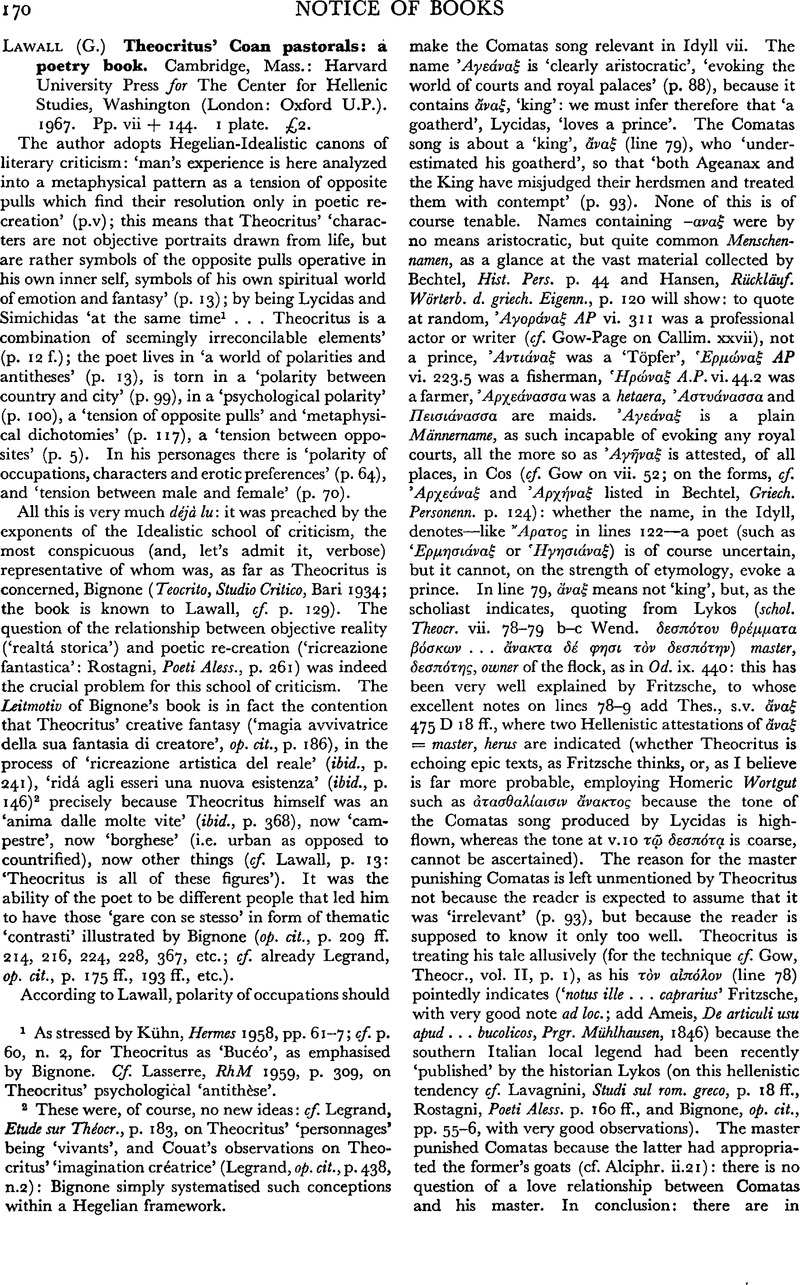Published online by Cambridge University Press: 23 December 2013

page 170 note 1 As stressed by Kühn, , Hermes 1958, pp. 61–7Google Scholar; cf. p. 60, n. 2, for Theocritus as ‘Bucéo’, as emphasised by Bignone. Cf. Lasserre, , RhM 1959, p. 309Google Scholar, on Theocritus' psychological ‘antithèse’.
page 170 note 2 These were, of course, no new ideas: cf. Legrand, , Etude sur Théocr., p. 183Google Scholar, on Theocritus' ‘personnages’ being ‘vivants’, and Couat's observations on Theocritus' ‘imagination créatrice’ (Legrand, op. cit., p. 438, n.2): Bignone simply systematised such conceptions within a Hegelian framework.
page 171 note 1 Cf. now Jachmann, 's pertinent and acute observations in ‘L'Arcadia come paesaggio bucolico’, Maia 1952, p. 161 ff.Google Scholar, especially for post-Theocritean developments; a systematic survey in Schönbeck, G., Der ‘locus amoenus’ von Homer bis Horaz, Diss. Heidelberg 1962.Google Scholar
page 172 note 1 Lasserre thinks that the harvested poetry is only Theocritus' vii Idyll; Lawall maintains that the harvest symbolises Theocritus' Idylls i to vii. On insect and animal symbols cf. Tribukait, , De proverbiis ap. bucolicos, Diss. Königsberg, 1889, 21 ff.Google Scholar
page 172 note 2 On these metaphors cf. Legrand, op. cit., p. 348, n. 2.
page 172 note 3 Reitzenstein's nonsense about chaste ‘boucoloi religieux’ (cf. Legrand, op. cit., p. 149) has unfortunately misled certain modem critics into forgetting the reputation of extreme amatory prowess which the profession enjoyed in antiquity. On ‘les moeurs des chevriers’ cf. Legrand, op. cit., p. 225, and my observations CR 1967, p. 22, where I explain Gow-Page 2063 ff., collating AP xii. 41.4. Cf. also Theocr. v. 41 ff., 116 f. and Gow on Theocr. i. 86, αἰπόλῳ. It would be easy to erect, for fun, an obscene interpretation of Idyll vii based on ‘symbolic’ elucidations: ![]() (
(![]() 34) =
34) = ![]() 19 =
19 = ![]() 43 =
43 = ![]()
![]() Arist. Pax. 965–7;
Arist. Pax. 965–7; ![]() in
in ![]() 66 = testiculi; 66
66 = testiculi; 66 ![]() =
= ![]()
![]() xiv. 26, cf. Gow on vii. 55
xiv. 26, cf. Gow on vii. 55 ![]()
![]() in
in ![]() 68 = pudenda muliebria, cf. metaphorical σέλινον amongst μῆλα and σισύμβρια in schol. Theocr. xi. 11 c Wend.; 52
68 = pudenda muliebria, cf. metaphorical σέλινον amongst μῆλα and σισύμβρια in schol. Theocr. xi. 11 c Wend.; 52 ![]() 62
62 ![]() erotic metaphors, cf. Lier, , Ad topica carm. amat. symb., Prgr. Gymn. Stettin 1914, §19Google Scholar, and e.g. AP xii. 167.3 (metaphor seen by Lawall, p. 89, but not carried to extreme consequences: why should Lycidas rejoice on the day when Ageanax has a lucky voyage, i.e. is lucky in love? Does Agenaxa's metaphorical lucky voyage mean that the youth is now old enough to embark on amorous adventures, and ‘too old to be a homosexual partner’, as happened to Philinus, cf. Lawall p. 96? If so, Lycidas consoles himself with metaphorical σέλινον, after Ageanax's voyage: obscene satire of genre propemptikon?); ὀπώρα 143 =
erotic metaphors, cf. Lier, , Ad topica carm. amat. symb., Prgr. Gymn. Stettin 1914, §19Google Scholar, and e.g. AP xii. 167.3 (metaphor seen by Lawall, p. 89, but not carried to extreme consequences: why should Lycidas rejoice on the day when Ageanax has a lucky voyage, i.e. is lucky in love? Does Agenaxa's metaphorical lucky voyage mean that the youth is now old enough to embark on amorous adventures, and ‘too old to be a homosexual partner’, as happened to Philinus, cf. Lawall p. 96? If so, Lycidas consoles himself with metaphorical σέλινον, after Ageanax's voyage: obscene satire of genre propemptikon?); ὀπώρα 143 = ![]() cf. LSJ, s.v. III, and Thes., s.v. ὀπώρα 2124 B–C: maturitas related to πεπαίτερος in line 120, cf. Thes. s.v. πεπαετερος; σαῦρος 22 = membrum virile, debilitated in the heat, cf. Hes., Erga 586, like Priapus A. Plan. 236: on the parallelism cf. Legrand, op. cit., p. 210, n. 3;
cf. LSJ, s.v. III, and Thes., s.v. ὀπώρα 2124 B–C: maturitas related to πεπαίτερος in line 120, cf. Thes. s.v. πεπαετερος; σαῦρος 22 = membrum virile, debilitated in the heat, cf. Hes., Erga 586, like Priapus A. Plan. 236: on the parallelism cf. Legrand, op. cit., p. 210, n. 3; ![]() = lecherous, cf. Arist., Physiogn. 811 b, quoted by Legrand p. 216, n. 3. May this specimen serve as an antidote against ‘symbolic’ interpretations of Theocritus.
= lecherous, cf. Arist., Physiogn. 811 b, quoted by Legrand p. 216, n. 3. May this specimen serve as an antidote against ‘symbolic’ interpretations of Theocritus.
page 172 note 1 Lawall rightly infers, from the αὖτις in line 156, that the festival was actually performed (p. 77).